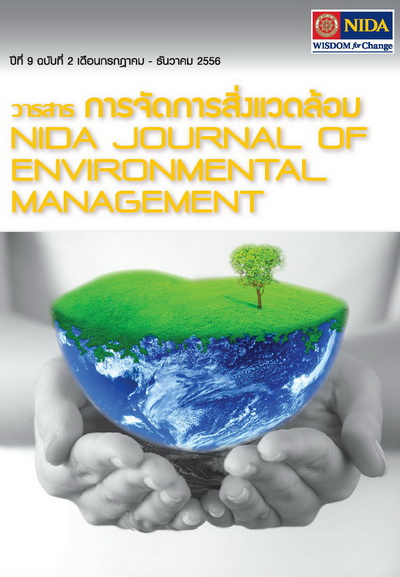การบริหารจัดการพลังงานหมุนเวียนเพื่อผลิตพลังงาน ใช้ในระดับชุมชนและระดับครัวเรือน: กรณีศึกษา ชุมชนเกาะพะลวย
บทคัดย่อ
บทคัดย่อ
การ ศึกษานี้มีวัตถุประสงค์ เพื่อถอดบทเรียนการจัดการพลังงานและการใช้พลังงานหมุนเวียนในชุมชนและครัว เรือน และเสนอแนวทางการวางแผน การบริหารจัดการ และการใช้พลังงานหมุนเวียนอย่างยั่งยืน กรณีศึกษา เกาะพะลวย ทำการเก็บรวบรวมข้อมูลโดยการสัมภาษณ์ผู้กำหนดนโยบายในการบริหารจัดการพลังงานหมุนเวียน 11 ท่านสัมภาษณ์เชิงลึกตัวแทนคณะกรรมการพลังงานและสิ่งแวดล้อมของเกาะพะลวยจำนวน 3 ท่าน แบบสอบถามประชาชนในชุมชน 30 ชุด และการสำรวจการใช้พลังงานหมุนเวียนในชุมชน ทำการวิเคราะห์ข้อมูลโดยใช้การวิเคราะห์เชิงเนื้อหาและการพรรณนาความ ร่วมกับการวิเคราะห์ข้อมูลเชิงปริมาณโดยใช้สถิติพรรณนา
ผลการศึกษา พบว่า เกาะพะลวยมีการนำพลังงานแสงอาทิตย์มาผลิตกระแส ไฟฟ้าใช้ในชีวิตประจำวัน ใช้กับตู้อบพลังงานแสงอาทิตย์เพื่อแปรรูปอาหารทะเลตากแห้งไว้รับประทาน และเพื่อจำหน่ายทำให้มีรายได้เพิ่มขึ้น การสูบน้ำด้วยไฟฟ้าพลังงานแสงอาทิตย์ ไปกักเก็บในถังน้ำแบบหอสูง เพื่อผลิตน้ำประปาใช้ในชุมชน การผลิตกระแสไฟฟ้าจากพลังงานลม การใช้เตาชีวมวลโดยใช้เศษไม้เป็นเชื้อเพลิงแทนการใช้ก๊าซหุงต้ม และการเผาโดยใช้เตาเผาถ่าน 200 ลิตร การ ใช้พลังงานชีวมวลในครัวเรือน เช่น ถ่านไม้ที่ผลิตจากเตาเผาถ่านประสิทธิภาพสูง มีการส่งเสริมปลูกพืชพลังงาน ส่งเสริมการใช้ไบโอดีเซลทดแทนการใช้น้ำมันดีเซลในรถยนต์และเรือประมงพื้น บ้าน ส่งเสริมการใช้หลอดไฟฟ้าประหยัดพลังงานในครัวเรือน สนับสนุนการใช้รถจักรยานยนต์ไฟฟ้า มีแนวทางการวางแผนการบริหารจัดการ การใช้พลังงานหมุนเวียนอย่างยั่งยืน โดยการส่งเสริมให้ความรู้ความเข้าใจและประโยชน์ของพลังงานหมุนเวียนแก่ชาว บ้าน การมีส่วนร่วมในการดำเนินการบริหารจัดการพลังงานหมุนเวียน การประชาสัมพันธ์ให้ประชาชนได้รับทราบข้อมูลเกี่ยวกับการใช้พลังงานหมุน เวียน และชาวบ้านต้องมีความคิดเห็นที่ตรงกันไม่ขัดแย้งกันเกี่ยวกับการนำพลังงาน หมุนเวียนมาใช้ประโยชน์ จะทำให้การบริหารจัดการพลังงานหมุนเวียนในระดับชุมชนและในระดับครัวเรือน ประสบผลสำเร็จยิ่งขึ้น
คำสำคัญ: การใช้พลังงานหมุนเวียน; ชุมชนและครัวเรือน; เกาะพะลวย
Abstract
This study is aimed at studying the management of renewable energy production and use at the household and community levels, focusing on Phaluai Island in Thailand, and then suggesting guidelines for sustainable management of renewable energy production and use. The data were collected through in-depth interviews with the administrators or those involved with the management of renewable energy production for consumption at the community and household levels, of eleven people, and community leaders and local energy boards on Phaluai Island for three people. A questionnaire was also used to survey the energy use and production and participation of people in the community. Content analysis was used to describe the results of in-depth interview, and descriptive statistics are used to analyze the results of the questionnaire.
The results showed that Phaluai Island has a solar cell to produce electricity for electricity appliances, lighting, pumping water, and that the island uses solar energy for seafood processing and preservation. Wind energy on the island is also used to produce electricity. Biomass, such as firewood produced from high-efficiency coal kilns, is used mainly in households. On this island, energy crops and biodiesel production are promoted. Energy-saving measures, such as the use of energy-saving light bulbs in houses, and electric bicycles, were encouraged. The measures for sustainable energy management on the island involved supporting knowledge about renewable energy by the people on the island and explaining its benefits, encouraging people to participate in renewable energy management, and perceiving information about renewable energy. Importantly, people on the island should see the same point and benefits of using renewable energy, and there should not be a conflict regarding renewable energy management and the use of renewable energy.
Keywords: Renewable Energy Use; Community and Household; Phaluai Island



